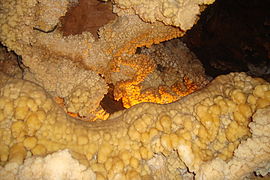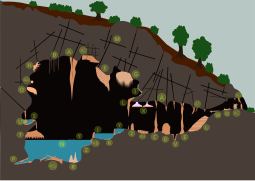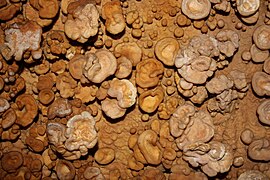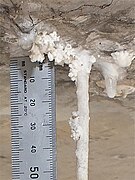Cave popcorn
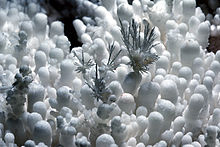
Cave popcorn, or coralloids, are small nodes of calcite, aragonite, or gypsum that form on surfaces in caves, especially limestone caves.[1][2] They are a common type of speleothem.[1][2]
Appearance
[edit]The individual nodules of cave popcorn range in size from 5 to 20 mm and may be decorated by other speleothems, especially aragonite needles or frostwork.[1][2] The nodules tend to grow in clusters on bedrock or the sides of other speleothems.[1] These clusters may terminate suddenly in either an upward or downward direction, forming a stratographic layer.[1] When they terminate in a downward direction, they may appear as flat-bottomed formations known as trays.[3][1]
Individual nodes of popcorn can assume a variety of shapes from round to flattened ear-like or button-like shapes.[2]
The color of cave popcorn is usually white, but various other colors are possible depending on the composition.[2]
Formation
[edit]Cave popcorn can form by precipitation.[1] Water seeping through limestone walls or splashing onto them leaves deposits when CO2 loss causes its minerals to precipitate.[2] When formed in this way, the resultant nodules have the characteristics of small balls of flowstone.[1]
Cave popcorn can also form by evaporation in which case it is chalky and white like edible popcorn.[1] In the right conditions, evaporative cave popcorn may grow on the windward side of the surface to which it is attached or appear on the edges of projecting surfaces.[1]
On manmade structures (outside the cave environment)
[edit]Popcorn can also occur on concrete structures outside the cave environment; these are classified as calthemite coralloids. Calthemite coralloids also occur in "artificial caves", such as mines, railways, or vehicle tunnels where there is a source of lime, mortar, or cement from which the calcium ions can be leached.
Coralloids can form by a number of different methods in caves; however, the most common form on concrete is created when a hyperalkaline solution seeps from fine cracks. Due to solution evaporation, deposition of calcium carbonate occurs before any drop can form. The resulting coralloids are small and chalky with a cauliflower appearance.[citation needed]
Gallery
[edit]-
Alisadr Cave, Hamedan, Iran
-
Cave popcorn trays
-
Diagram of dripstone cave structures (cave popcorn labelled AH)
-
Button cave popcorn
-
Calthemite coralloids under concrete, with soda straw
References
[edit]- ^ a b c d e f g h i j Palmer, Arthur N. (2007). Cave Geology. Dayton, OH: Cave Books. p. 288. ISBN 978-0-939748-66-2.
- ^ a b c d e f Hill, Carol; Forti, Paolo (1997). Cave Minerals of the World (Second ed.). Huntsville, AL: National Speleological Society. pp. 59–61. ISBN 1-879961-07-5.
- ^ "Trays". The Virtual Cave. National Speleological Society.
External links
[edit]- "Popcorn". The Virtual Cave. National Speleological Society.
- "Coralloids". The Virtual Cave. National Speleological Society.
- "Trays". The Virtual Cave. National Speleological Society.
- Kids' page on popcorn, Underground Adventures (archived)
- National Park Service page on popcorn

